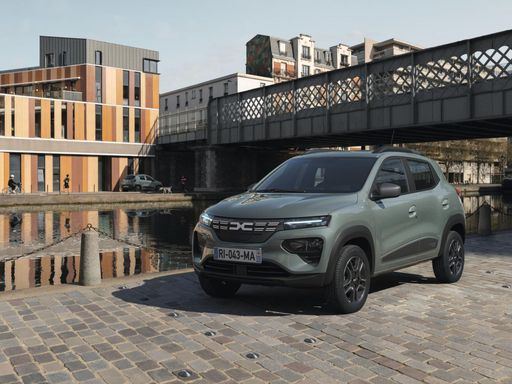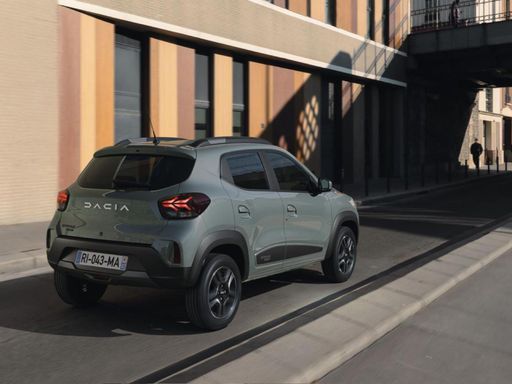Dacia Spring vs Kia PV5 - Differences and prices compared
Costs and Efficiency:
Looking at overall running costs, both models reveal some interesting differences in everyday economy.
Dacia Spring has a convincingly advantage in terms of price – it starts at 14500 £, while the Kia PV5 costs 32800 £. That’s a price difference of around 18335 £.
In terms of energy consumption, the advantage goes to the Dacia Spring: with 13.20 kWh per 100 km, it’s decisively more efficient than the Kia PV5 with 19.80 kWh. That’s a difference of about 6.60 kWh.
As for range, the Kia PV5 performs significantly better – achieving up to 400 km, about 172 km more than the Dacia Spring.
Engine and Performance:
Power, torque and acceleration say a lot about how a car feels on the road. This is where you see which model delivers more driving dynamics.
When it comes to engine power, the Kia PV5 has a clearly edge – offering 163 HP compared to 65 HP. That’s roughly 98 HP more horsepower.
In acceleration from 0 to 100 km/h, the Kia PV5 is clearly perceptible quicker – completing the sprint in 10.70 s, while the Dacia Spring takes 13.70 s. That’s about 3 s faster.
In terms of top speed, the Kia PV5 performs slight better – reaching 135 km/h, while the Dacia Spring tops out at 125 km/h. The difference is around 10 km/h.
There’s also a difference in torque: Kia PV5 pulls significantly stronger with 250 Nm compared to 125 Nm. That’s about 125 Nm difference.
Space and Everyday Use:
Whether family car or daily driver – which one offers more room, flexibility and comfort?
Seats: Kia PV5 offers to a small extent more seating capacity – 5 vs 4.
In curb weight, Dacia Spring is decisively lighter – 1013 kg compared to 1860 kg. The difference is around 847 kg.
In terms of boot space, the Kia PV5 offers significantly more room – 1320 L compared to 308 L. That’s a difference of about 1012 L.
In maximum load capacity, the Kia PV5 performs convincingly better – up to 4420 L, which is about 3416 L more than the Dacia Spring.
When it comes to payload, Kia PV5 significantly takes the win – 790 kg compared to 302 kg. That’s a difference of about 488 kg.
Who comes out on top?
Overall, the Kia PV5 shows itself to be leaves the rival little chance and secures the title of DriveDuel Champion.
It convinces with the more balanced overall package and proves to be the more versatile choice for everyday use.

Kia PV5
Costs and Consumption
View detailed analysis
Engine and Performance
View detailed analysis
Dimensions and Body
View detailed analysis
Dacia Spring
The Dacia Spring is an unpretentious city electric that strips EV ownership down to the essentials, offering clean, fuss-free transport for daily urban life. It won't impress luxury-seekers, but its cheerful practicality and rock-bottom running costs make it a clever, no-nonsense choice for anyone who wants electric mobility without the drama.
details @ Dacia / Renault Group Media
@ Dacia / Renault Group Media
 @ Dacia / Renault Group Media
@ Dacia / Renault Group Media
 @ Dacia / Renault Group Media
@ Dacia / Renault Group Media
Kia PV5
The Kia EV5 is an exciting new entrant in the landscape of electric SUVs, promising a blend of style and innovation that captures attention. It boasts a sleek and modern design that aligns with Kia's evolving aesthetic identity, blending practicality with eye-catching details. With its foray into the electric vehicle segment, the EV5 is set to offer a highly competitive option for those looking to embrace sustainable mobility without compromising on comfort or tech features.
details
 @ Dacia / Renault Group Media
@ Dacia / Renault Group Media
|
|
|
|
|
Costs and Consumption |
|
|---|---|
|
Price
14500 - 17100 £
|
Price
32800 - 38900 £
|
|
Consumption L/100km
-
|
Consumption L/100km
-
|
|
Consumption kWh/100km
13.2 - 14.1 kWh
|
Consumption kWh/100km
19.8 - 20.3 kWh
|
|
Electric Range
225 - 228 km
|
Electric Range
288 - 400 km
|
|
Battery Capacity
26.80 kWh
|
Battery Capacity
51.5 - 71.2 kWh
|
|
co2
0 g/km
|
co2
0 g/km
|
|
Fuel tank capacity
-
|
Fuel tank capacity
-
|
Dimensions and Body |
|
|---|---|
|
Body Type
SUV
|
Body Type
Cargo Van, Bus
|
|
Seats
4
|
Seats
2 - 5
|
|
Doors
5
|
Doors
4 - 5
|
|
Curb weight
1013 - 1050 kg
|
Curb weight
1860 - 2145 kg
|
|
Trunk capacity
308 L
|
Trunk capacity
1320 L
|
|
Length
3701 mm
|
Length
4695 mm
|
|
Width
1583 mm
|
Width
1850 - 1895 mm
|
|
Height
1519 mm
|
Height
1923 mm
|
|
Max trunk capacity
1004 L
|
Max trunk capacity
2300 - 4420 L
|
|
Payload
265 - 302 kg
|
Payload
505 - 790 kg
|
Engine and Performance |
|
|---|---|
|
Engine Type
Electric
|
Engine Type
Electric
|
|
Transmission
Automatic
|
Transmission
Automatic
|
|
Transmission Detail
Reduction Gearbox
|
Transmission Detail
Reduction Gearbox
|
|
Drive Type
Front-Wheel Drive
|
Drive Type
Front-Wheel Drive
|
|
Power HP
44 - 65 HP
|
Power HP
121 - 163 HP
|
|
Acceleration 0-100km/h
13.7 - 19.1 s
|
Acceleration 0-100km/h
10.7 - 16.3 s
|
|
Max Speed
125 km/h
|
Max Speed
135 km/h
|
|
Torque
113 - 125 Nm
|
Torque
250 Nm
|
|
Number of Cylinders
-
|
Number of Cylinders
-
|
|
Power kW
33 - 48 kW
|
Power kW
89 - 120 kW
|
|
Engine capacity
-
|
Engine capacity
-
|
General |
|
|---|---|
|
Model Year
2024
|
Model Year
2025
|
|
CO2 Efficiency Class
A
|
CO2 Efficiency Class
A
|
|
Brand
Dacia
|
Brand
Kia
|
What drive types are available for the Dacia Spring?
The Dacia Spring is available as Front-Wheel Drive.
The prices and data displayed are estimates based on German list prices and may vary by country. This information is not legally binding.
